| Figure T-61.1 | Figure T-61.2 |
|---|---|
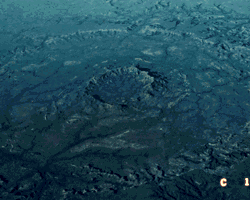 |
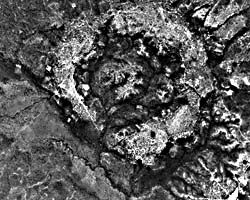 |
| Figure T-61.1 | Figure T-61.2 |
|---|---|
 |
 |
Space imagery has proved, as demonstrated in this Plate, to be a powerful tool in the search for meteorite/asteroid impact sites on the Earth's land surface. More than 200 confirmed, probable, or suspected craters and astroblemes (the eroded scars or roots of the initial impact structure) have been located by conventional means on every continent except Antarctica. The bulk of these were identified from field work and drilling. With the advent of space photography, a number of circular features -most already known but a few seemingly new- were highlighted in the synoptic coverage, prompting renewed interest and, in several instances, actual expeditions to investigate their nature. Although a few indeed were impact structures, that nature generally turned out to be one or more of the following: (1) structural domes, (2) intrusive plutons, (3) fracture patterns, (4) erosional or collapse basins, (5) an artifact of illumination, (6) chance morphological patterns, or (7) simply unexplained. With the worldwide coverage offered by Landsat, new efforts are being directed toward a careful quest for suspicious structures or patterns that could then be field-checked. As an example of the modus operandi, the author (NMS) "discovered" the Araguainha Dome in Mato Grosso, Brazil, in a Landsat scene; by coincidence, on the same day, a colleague at GSFC was "discovering" petrographic microscope evidence of impact- induced shock metamorphism in thin sections of rocks from that locality. Even though Landsat did not originally find this structure, the image brought to light the realization that its diameter was almost twice that initially assigned from ground studies.
R. S. Dietz and J. McHone of Arizona State University were among the first to scan through numerous Landsat scenes seeking signs of previously undetected impact structures. Generally, the most common observable features are: (1) pattern circularity (distortions may occur from subsequent tectonic disturbance and/or erosional irregularities), (2) rimmed depressions (if a crater still persists), and (3) central peaks (if large enough); ejecta is almost certainly absent (long since removed) and volcanism is seldom evident.
The collection of image subsets in the Plate has been supplied by J. McHone, who also furnished much of the following abstracted commentary. Scales of the individual insets vary.
A. Manicouagan (Quebec): This astrobleme, impressed on Precambrian rocks, is at least 66 km in diameter. Vestiges of an initial rim cannot be discerned, suggesting removal if formed. A broad central uplift persists; many of the anorthosites making up Mt. Babel in this interior are now converted to maskelynite (feldspar glass). A surrounding depression has since been filled with water following the construction of a hydroelectric dam.
| Plate T-61.A | Plate T-61.B |
|---|---|
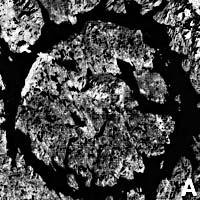 |
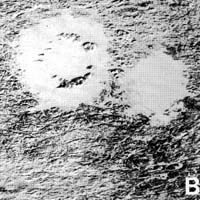 |
B. Clearwater Lakes (Quebec): This pair of structural depressions (30- and 20-km diameters), east of Hudson Bay, also consists of astroblemes, now much eroded and glaciated, cut into Precambrian crystalline rocks. Abundant evidence of shock damage, impact melt, and shatter cones remain in these rocks. West Clearwater has a central (uplift) rim rising above lake level.
C. Serra da Cangalha (Brazil): Landsat played a large role in pinpointing this ring structure (~12-km diameter), with its central depression. About 50 km to the northeast is the smaller (4 km) Riachao Ring (mounted here as an inset) with its peripheral circle of ejecta. Shock features have been recognized at both sites. An aerial oblique photograph of Cangalha (Figure T-61.1) and an aerial vertical photograph of Riachao (Figure T-61.2) together illustrate the geomorphic expression of impact structures in a typical low-relief setting.
| Plate T-61.C | Plate T-61.D |
|---|---|
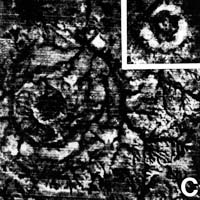 |
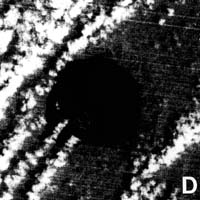 |
D. Lake Ashanti (also known as Bosumtwi) (Ghana): This part of equatorial Africa is seldom free of clouds, so that this good look at the lake-filled crater (~10-km diameter) is exceptional. Shock criteria, including coesite, place this structure in the meteorite impact category. It is also believed to be the site of origin of the Ivory Coast microtektites.
| Plate T-61.E | Plate T-61.F |
|---|---|
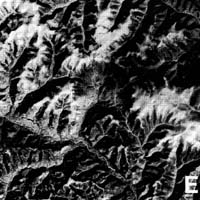 |
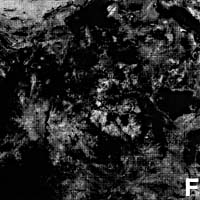 |
E. Logancha (Siberia, U.S.S.R.): In the last two decades, Soviet scientists have examined a number of circular structures, some quite evident in space imagery (best example: El'gygytgyn). Because this subscene occurs on an expansive volcanic plateau, an endogenetic origin is implied. However, reports of shatter cones from its central area make it a candidate impact structure.
F. Zhamanshin (U.S.S.R.): This small astrobleme (~10-km diameter) is greatly eroded and difficult to detect. A variety of shock features are present, including glasses (irghizites) that share much in common with Australasian tektites.
| Plate T-61.G | Plate T-61.H |
|---|---|
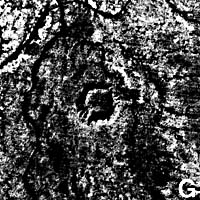 |
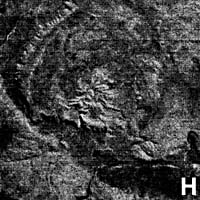 |
G. Ramghar (India): This structure, of questionable origin, lies about 300 km south of Delhi in Precambrian/Early Paleozoic terrane. It is a ring (~3-km diameter) analogous to the Gosses Bluff impact structure in central Australia, but no shock features have yet been reported here.
H. "The Spider" (Northwest Australia): This structure consists of a central peak of steep-dipping beds, bearing shatter cones, moved upward and inward from below.
| Plate T-61.I | Plate T-61.J |
|---|---|
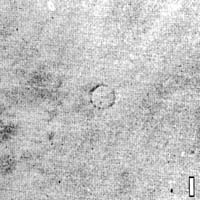 |
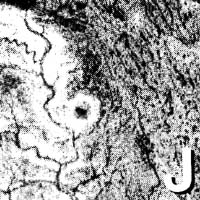 |
I. Talemzane (Algeria): This Landsat image shows that sand has partially buried this 1.75-km rimrock ring, around which megabreccias have survived.
J. Talemzane (Algeria): This SIR-A radar image shows the crater rim to be a bright backscattering surface owing to blocky fractured bedrock and breccia clasts.
| PlateT-61.K |
|---|
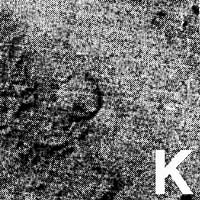 |
K. Tenoumer Crater (Mauritania): Another rimmed structure, 1.8 km wide, sticks out from a thin veneer of Sahara sands.
In addition to the above, other terrestrial impact structures illustrated in this book are Gosses Bluff (Figure 1-4), Meteor Crater (Plate V-3), and El'gygytgyn (Figures 12-14a, 12-14b, 12-14.c and 12-14.d. (NMS) Montage of Landsat Subscenes.
Continue to Chapter 2 References| Chapter 2 table of Contents| Return to Home Page| Complete Table of Contents